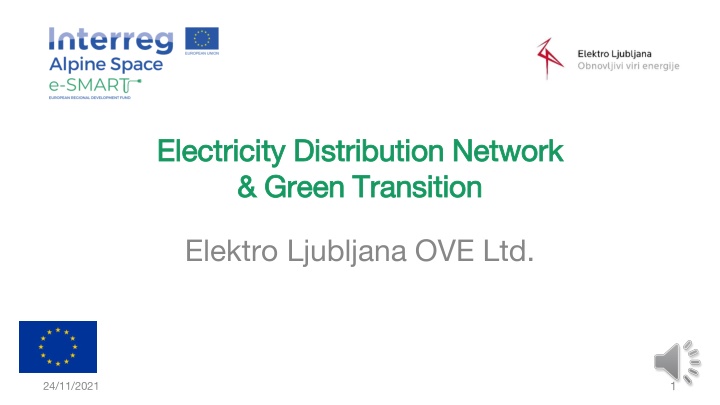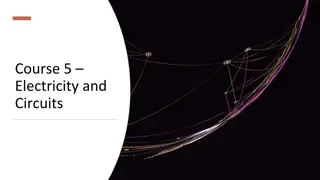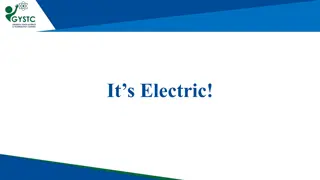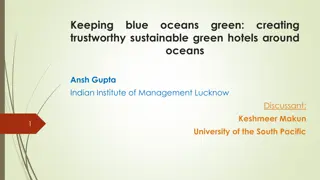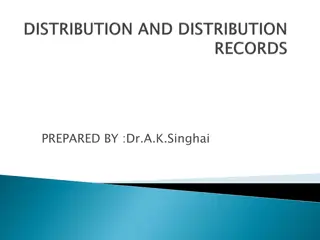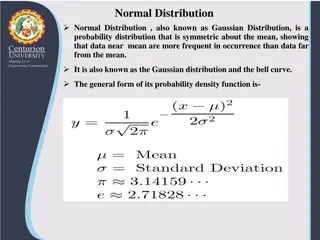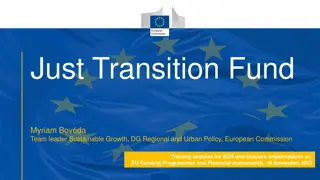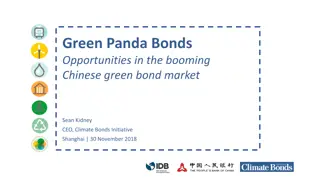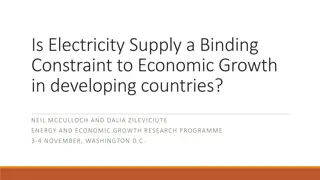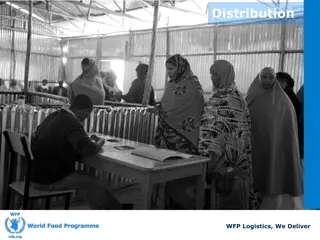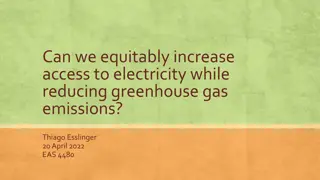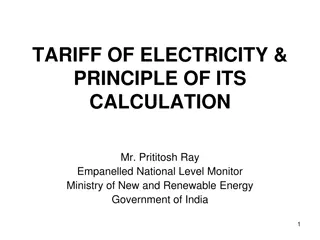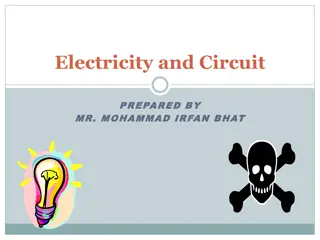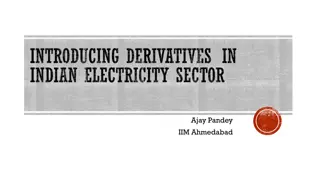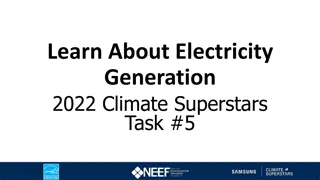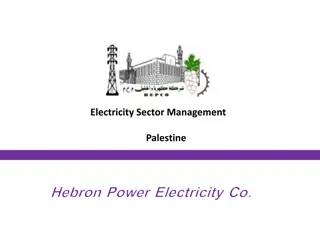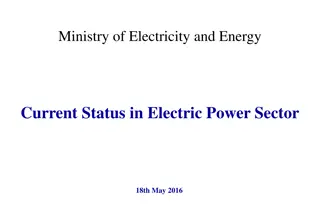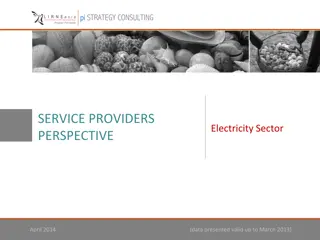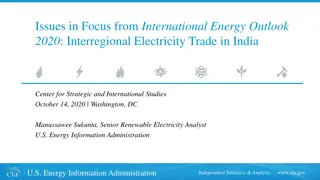Electricity Distribution Network & Green Transition
Growing electricity consumption and the shift towards CO2 neutrality pose significant challenges for the electricity distribution network, requiring substantial investments and adaptations to meet future demands. The impact of electric heating with heat pumps and the need for increased green electricity generation are key factors driving these changes.
Download Presentation

Please find below an Image/Link to download the presentation.
The content on the website is provided AS IS for your information and personal use only. It may not be sold, licensed, or shared on other websites without obtaining consent from the author.If you encounter any issues during the download, it is possible that the publisher has removed the file from their server.
You are allowed to download the files provided on this website for personal or commercial use, subject to the condition that they are used lawfully. All files are the property of their respective owners.
The content on the website is provided AS IS for your information and personal use only. It may not be sold, licensed, or shared on other websites without obtaining consent from the author.
E N D
Presentation Transcript
Electricity Distribution Network Electricity Distribution Network & Green Transition & Green Transition Elektro Ljubljana OVE Ltd. 1 24/11/2021
Electricity consumption growth expectations Electricity consumption growth expectations National Energy and Climate Plan (NECP = NEPN) estimates 70% increase in electric power generation till 2050. Todays primary energy supply of Slovenia is at the level of 70 TWh. If we don t implement totally new technologies not known yet, increase in electricity demand will be much higher. To become CO2 neutral society, estimation of needed green electricity generation goes up to almost 40 TWh (double the values from NECP) Source: NEPN, MZI 2020
CO2 neutrality CO2 neutrality Impact on Electric Energy Distribution Network Impact on Electric Energy Distribution Network By 2050 in SLO 40 GW mostly distributed generation capacity is expected while today s total electric energy generation capacity is about 3 GW. RES mostly connected to the distribution network, where today only about 0,4 GW is connected. Distribution of 40 TWh of energy instead of today s 12,5 TWh. In ideal case minimum needed increase in network capacity is 250-300%, but probably close to 400%. With today s investment, we increase network capacity by 1,5 3 % / year -> could take up to 100 years. Increase of investment for at least 300% is needed.
EU estimates EU estimates Power Barometer (Eurelectric) estimates the investment needs into the distribution network to double from 33,5 billion EUR/year to 60 during 2021-2030. EU commission estimates these needs to 60 to 110 billion EUR/year (200 - almost 400%). Our estimates are at 350%. Imagine influence on network tariffs and costs for EE and consequentially competitiveness of EU economy. Where to find founds and human resources? Distribution network needs all possible support to follow these trends and overcome all bottlenecks on that way. Source: Power Barometer, Eurelectric, 2019. EU commission estimate need to increase investments in electric power networks in Slovenia from 150 to 170 M EUR (DSO and TSO) to 240 to 450 M EUR each year.
Causes of demand increase Causes of demand increase Electric heating with Heat Pumps Electric heating with Heat Pumps Most strategies of sustainable development relays on electrification of heating. At EU level, already by 2030 four (4) times more heat pumps is estimated, then now. In SLO number of heat pumps rises very quickly. Their total electric capacity is already over 270 MW (13% of peak load of the country). Estimated number of heat pumps for 2030 is 200.000 with total loading of additional 950 MW. Source: Eco fund. Picture: Elektro Maribor, 2020. In 2019 number of heat pumps increased for 53 %. Istalled capacity rised for 67 MW.
Causes of demand increase Causes of demand increase E E mobility mobility National goal of transport electrification is set to 200.000 EVs in 2030: 200.000 EVs will increase peak loading of the distribution network for 400 MW, if done in today s manner 20% of todays peak power. 1.000.000 cars by 2050 -> ?? MW Transport of goods, air transport, sea/water ways transport -> MW In 2020 less than 1000 electric cars (BV) were sold in Slovenia. To reach 2030 target, 20.000 should be sold every year. Source: The impact of mass electrification of passenger traffic and heating on the development of the distribution network , EIMV, 2018.
Causes of demand increase Causes of demand increase RES integration RES integration Experiences show, that RES do not decrease network loading, but increase it. PV generation does not correspond to the power needs in time. In 2020, 370 MW PV sources installed generated 0,29 TWh we are on 0,75% way to carbon neutrality. To reach 2030 RES targets, we need to increase construction intensity by 10x. Source: Elektro Ljubljana (2016 2020)
How to support faster Electric Energy Distribution How to support faster Electric Energy Distribution Network development Network development Simplify building permit procedures and decrease associated costs (network improvement is precondition for carbon neutral society and supposed to be in public interest! is it?) Adapt regulation to be stimulative for the network owners to improve the system Coordinate spatial planning with actual state of distribution network and most effective possibilities for development Make also Renewable Energy Source operators to take share in responsibility for power quality parameters in the network Source: Slovenian DSO-s 2019. Picture: Elektro Maribor, 2020. Source: Slovenian DSO-s 2019. Picture: Elektro Maribor, 2020.
Problems in getting construction permits SLO Problems in getting construction permits SLO example example - -NATURA 2000 NATURA 2000 There are 355 protected areas in the frame NATURA 2000 in Slovenia These areas are covering 37,46 % of the surface of entire country of Slovenia Due to complicated procedures, considerable parts of project costs are spent only to get permission to build. Procedures take up to 10 years Source: http://www.natura2000.si
How DSO can contribute How DSO can contribute Energy efficiency reduces emissions. Losses reduction (I2R) is best contribution, distribution can give. Very small potential limited with power quality. RES have generally opposite effect. Source: CEER report on power losses 2020
Power Quality Power Quality parameters parameters Not only the shape and amplitude of voltage sinusoidal Also interruptions in the power supply Different influences on the grid! Need of higher cap Source: CEER benchmark report 2018
Network construction Network construction The most efficient way to robust network? Underground cables! No smart solution is more effective! Souce: CEER benchmark report 2018 DSO-s need support to bring the network underground and essentially increase capacity.
Whom to contact? Whom to contact? For more information, please contact Damjan Kresal Elektro Ljubljana OVE Ltd. damjan.kresal@el-ove.si 13 Date 24/11/2021
